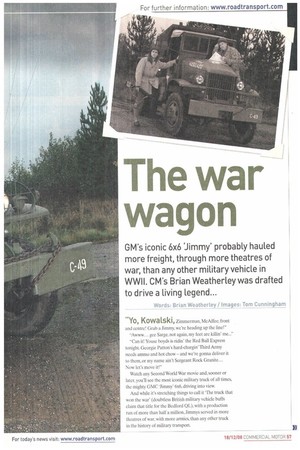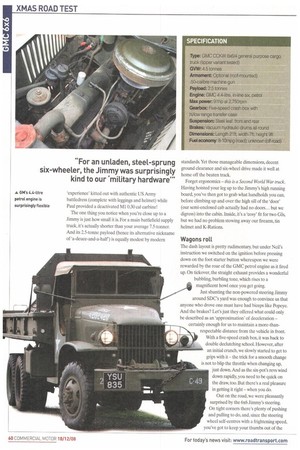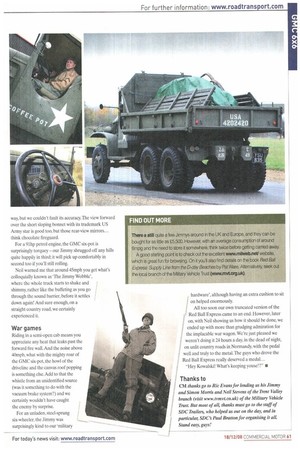The war wagon
Page 57

Page 58

Page 60

Page 61

If you've noticed an error in this article please click here to report it so we can fix it.
GM's iconic 6x6 'Jimmy' probably hauled more freight, through more theatres of war, than any other military vehicle in WWII. CM's Brian Weatherley was drafted to drive a living legend...
Words: Brian Weatherley / images: Tom Cunningham
Ad
Yo, Kowalski, Zimmerman, McAffee, front and centre! Grab a Jimmy, we're heading up the line!"
"Awww... gee Sarge, not again, my feet are killin' me..."
"Can it! Youse boyds is ridin' the Red Ball Express tonight. Georgie Patton's hard-chargin' Third Army needs ammo and hot chow — and we're gonna deliver it to them, or my name ain't Sergeant Rock Granite... Now let's move it!"
Watch any Second World War movie and, sooner or later, you'll see the most iconic military truck of all times, the mighty GMC 'Jimmy' 6x6, driving into view.
And while it's stretching things to call it 'The truck that won the war' (doubtless British military vehicle buffs claim that title for the Bedford QL), with a production run of more than half a million, Jimmys served in more theatres of war, with more armies, than any other truck in the history of military transport. There's no better exemplar of the pledge made by US president Franklin D Roosevelt that America would become "Democracy's arsenal!" than the Jimmy.
From Bastoigne to Berlin, Guadalcanal to Greenland, it was the US Forces' most widely used tactical transport during the Second World War. No wonder frontline troops loved the Jimmy. Not only did it take them into battle, but it also kept them re-supplied — especially during the critical period immediately after the D-Day landings, when frontline troops needed a huge re-supply to fuel the vital breakout from the Normandy beachhead.
For three-months, the US Army ran a non-stop priority shuttle of food, fuel and ammunition to the rapidly moving frontline, in what became known as the "Red Ball Express". Driven mainly by black American GIs (although rear-echelon units were frequently plundered for fresh drivers), the Red Ball Jinunys ran a high-speed 24-hour service on a one-way loop to ensure the Allied forward thrust didn't stall. If a truck broke down, it was simply bulldozed out of the way and (maybe) recovered later. And if the brakes on your Jimmy were lacking in bite, to stop it, simply run into the back of the one in front...
The call-up
A few weeks ago, CM got its call-up papers courtesy of Paul Bratton, sales director at SDC Trailers and unashamed military vehicle enthusiast. Bratton has previously owned a share in a Jimmy, although he's currently downsized to a Jeep. However, through his membership of the Trent Valley Military Vehicle Trust (TVMVT) and friendship with fellow TVMVT member and Jimmy owner Ric Evans, we were able to drive Ric's tipper-bodied GMC on a 26-mile journey from SDC's Mansfield site to a top secret location 'somewhere in England' (OK, an airfield outside Newark) for our photoshoot.
Accompanying us was another TVMVT stalwart, Neil Stevens, who, despite an unlikely background for a military vehicle enthusiast (he's the English regional representative for the Rail Freight Group!), is also a former Jimmy owner and keen amateur historian with a particular interest in the US forces based in his native Wiltshire during the Second World War — and their vehicles.
It was thanks to Neil, an accomplished Jimmy driver in his own right, that we were able to enjoy the full Second World War 'experience' kitted out with authentic US Army battledress (complete with leggings and helmet) while Paul provided a deactivated MI 0.30 cal carbine!
The one thing you notice when you're close up to a Jimmy is just how small it is. For a main battlefield supply truck, it's actually shorter than your average 75-tonner. And its 23-tonne payload (hence its alternative nickname of 'a-deuce-and-a-half) is equally modest by modern standards. Yet those manageable dimensions, decent ground clearance and six-wheel drive made it well at home off the beaten track.
Forget ergonomics — this is a Second World War truck. Having hoisted your leg up to the Jimmy's high running board, you've then got to grab what handholds you can, before climbing up and over the high sill of the 'door' (our semi-enclosed cab actually had no doors.., but we digress) into the cabin. Inside, it's a 'cosy' fit for two GIs, but we had no problem stowing away our firearm, tin helmet and K-Rations.
Wagons roll
The dash layout is pretty rudimentary, but under Neil's instruction we switched on the ignition before pressing down on the foot starter button whereupon we were rewarded by the roar of the GMC petrol engine as it fired up. On tickover, the straight exhaust provides a wonderful bubbling, burbling tone, which rises to a magnificent howl once you get going.
Just shunting the non-powered steering Jimmy around SDC's yard was enough to convince us that anyone who drove one must have had biceps like Popeye. And the brakes? Let's just they offered what could only be described as an 'approximation' of deceleration — certainly enough for us to maintain a more-thanrespectable distance from the vehicle in front.
With a five-speed crash box, it was back to double declutching school. However, after an initial crunch, we slowly started to get to grips with it — the trick for a smooth change is not to blip the throttle when changing up, just down. And as the six-pot's revs wind down rapidly, you need to be quick on the draw, too. But there's a real pleasure in getting it right — when you do.
Out on the road, we were pleasantly surprised by the 6x6 Jimmy's steering. On tight corners there's plenty of pushing and pulling to do, and, since the steering wheel self-centres with a frightening speed, you've got to keep your thumbs out of the way, but we couldn't fault its accuracy. The view forward over the short sloping bonnet with its trademark US Army star is good too, but those rear-view mirrors... think chocolate fireguard.
For a 91hp petrol engine, the GMC six-pot is surprisingly torquey — our Jimmy shrugged off any hills quite happily in third; it will pick up comfortably in second too if you'll still rolling.
Neil warned me that around 45mph you get what's colloquially known as 'The Jimmy Wobble', where the whole truck starts to shake and shimmy, rather like the buffeting as you go through the sound barrier, before it settles down again! And sure enough, on a straight country road, we certainly experienced it.
War games
Riding in a semi-open cab means you appreciate any heat that leaks past the forward fire wall. And the noise above 411mph, what with the mighty roar of the GMC six-pot, the howl of the driveline and the canvas roof popping is something else. Add to that the whistle from an unidentified source (was it something to do with the vacuum brake system?) and we certainly wouldn't have caught the enemy by surprise.
For an unladen, steel-sprung six-wheeler, the Jimmy was surprisingly kind to our 'military hardware', although having an extra cushion to sit on helped enormously.
1 All too soon our own truncated version of the il Red Ball Express came to an end. However, later on, with Neil showing us how it should be done, we ended up with more than grudging admiration for the implacable war wagon. We're just pleased we weren't doing it 24 hours a day, in the dead of night, on unlit country roads in Normandy, with the pedal , well and truly to the metal, The guys who drove the ; Red Ball Express really deserved a medal... "Hey Kowalski! What's keeping youse!?" •




































































































































































